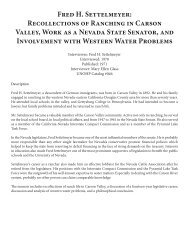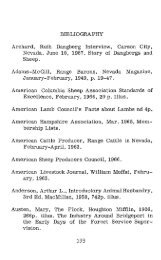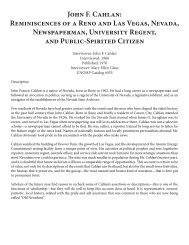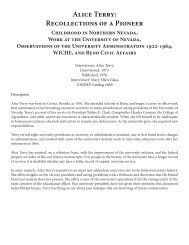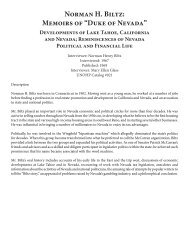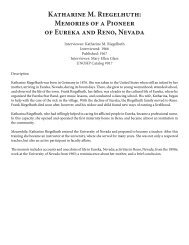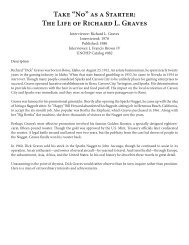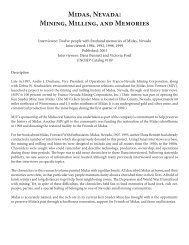Silvio Petricciani - University of Nevada, Reno
Silvio Petricciani - University of Nevada, Reno
Silvio Petricciani - University of Nevada, Reno
You also want an ePaper? Increase the reach of your titles
YUMPU automatically turns print PDFs into web optimized ePapers that Google loves.
Life in <strong>Reno</strong>, 1930-1943<br />
29<br />
on the corner <strong>of</strong> Liberty and Virginia Street.<br />
It was on the northeast corner <strong>of</strong> Liberty and<br />
Virginia where Security National Bank is now.<br />
Used to be a big garage there. As a matter <strong>of</strong><br />
fact my dad used to keep his car there; and<br />
for thirty dollars a month, when he’d come<br />
home at night, the attendant would bring<br />
him home, bring the car back, put it in the<br />
garage, and in the morning he’d call for his<br />
car and they’d bring it to him. As a matter <strong>of</strong><br />
fact, Myron Frank, his son, just died recently.<br />
They had the old Grand Central Garage and<br />
then they had the old <strong>Reno</strong> Garage here now<br />
where the telephone company is now. And<br />
then his sons, his stepsons, now own the First<br />
National Bank Parking Garage there; one is<br />
a lawyer (I went to school with him), George<br />
Folsom. They were Myron Frank’s stepsons.<br />
The sane publication mentioned Frank Cochran<br />
and Buzz Morrison, commercial pilots and<br />
instructors.<br />
Buzz Morrison, Frank Cochran—I just<br />
remember the names. They were commercial<br />
pilots, and I think Cochran had something to<br />
do with the old Air Service Company, if I’m<br />
not mistaken.<br />
How were slot machines in the thirties different<br />
than the ones we have today?<br />
Oh, the slot machines in the thirties were<br />
very much different than the ones we have<br />
today. Of course you must remember that slot<br />
machines in those days were not regulated.<br />
And before gaming was legalized, why as I<br />
told you before slot machines were put on<br />
location, and <strong>of</strong> course the operator furnished<br />
the slot machine, the proprietor furnished the<br />
place, and they split the take fifty-fifty. And<br />
the slot machines in those days were, first<br />
they had the old Caille slot machines, the big<br />
round dial in the middle; you’d put a coin in<br />
at the top and pull the coin down, then push a<br />
handle and the wheel would go around and it<br />
would stop on certain pays. And they weren’t<br />
as liberal, <strong>of</strong> course, as they are today, a little<br />
tighter on the pay<strong>of</strong>f, around seventy percent<br />
pay<strong>of</strong>f and thirty percent for the house.<br />
And then as time went on they came<br />
into the smaller slot machines. There was<br />
Caille and Mills—what’s the other one? But<br />
the Cailles and the Mills were the two most<br />
prominent slot machines. And Bally was<br />
unknown <strong>of</strong> or unheard <strong>of</strong> in those days. Of<br />
course everything was mechanical; nothing<br />
was electronic in those days. The advent <strong>of</strong><br />
electronic slot machines was with the old<br />
pinball games, and actually they didn’t know<br />
in those days the electronics that they had<br />
in pinball games could be applied to a slot<br />
machine. The technology wasn’t there because<br />
there was no pay<strong>of</strong>fs with the pinball games,<br />
you know. They’d just click and make lights go<br />
on, so on and so forth. And <strong>of</strong> course it was<br />
all hard-wired as opposed to transistors and<br />
diodes and all that kind <strong>of</strong> stuff now.<br />
But they were really very simple<br />
mechanically. And not up until I’d say 1934<br />
or so, did they have say a fifty-cent machine;<br />
people didn’t have money to play dollar slot<br />
machines in those days. Of course even on<br />
the gaming tables you could play “21” for a<br />
quarter. Oh, yes. People didn’t have the money<br />
in those days to gamble big.<br />
Jennings was the other big manufacturer<br />
<strong>of</strong> slot machines, but Mills was the most<br />
prominent slot machine and the most<br />
trouble free. And all <strong>of</strong> their pay<strong>of</strong>fs were<br />
made mechanically, <strong>of</strong> course, through<br />
slides which—I still have some machines up<br />
here. And along came Pace; they built a slot<br />
machine which was a very good slot machine.<br />
Wasn’t a good slot machine mechanically, but<br />
it got a lot <strong>of</strong> play. That’s where Harold [Smith]



